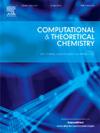DFT and Monte Carlo Study of Chalcone Compounds as Corrosion Inhibitors: Influence of Various Substituents (R = Cl, Br, CH3, OCH3, NH2, OH, N(CH3)2, H, COOH)
IF 3
3区 化学
Q3 CHEMISTRY, PHYSICAL
引用次数: 0
Abstract
This study explores the corrosion inhibition properties of ten chalcone derivatives (Ch1–Ch10) using advanced computational techniques. Density Functional Theory (DFT) calculations were conducted using the B3LYP functional with the 6–311 + G(d,p) basis set to evaluate the electronic properties of the molecules. In addition, Monte Carlo simulations were used to model the adsorption behavior of the chalcone derivatives on Fe (110) and Cu (111) surfaces. Among the derivatives, Ch1 displayed the largest HOMO-LUMO energy gap (3.066 eV) and the highest hardness (1.553 eV), indicating significant molecular stability and low chemical reactivity. Its optical properties, including a refractive index of 2.0388 and a dielectric constant of 4.1568, suggested low polarizability. However, despite these stable and inert characteristics, Ch1 showed limited potential as a corrosion inhibitor. In contrast, Ch7 and Ch10 exhibited the strongest adsorption interactions in the Monte Carlo simulations, suggesting that these compounds have the greatest potential as effective corrosion inhibitors on both Fe (110) and Cu (111) surfaces.

求助全文
约1分钟内获得全文
求助全文
来源期刊

Computational and Theoretical Chemistry
CHEMISTRY, PHYSICAL-
CiteScore
4.20
自引率
10.70%
发文量
331
审稿时长
31 days
期刊介绍:
Computational and Theoretical Chemistry publishes high quality, original reports of significance in computational and theoretical chemistry including those that deal with problems of structure, properties, energetics, weak interactions, reaction mechanisms, catalysis, and reaction rates involving atoms, molecules, clusters, surfaces, and bulk matter.
 求助内容:
求助内容: 应助结果提醒方式:
应助结果提醒方式:


